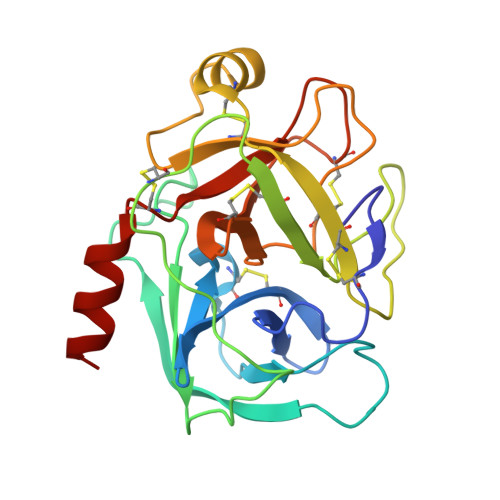Discovery of 1-(2-Aminomethylphenyl)-3-trifluoromethyl-N-[3-fluoro-2'-(aminosulfonyl)[1,1'-biphenyl)]-1H-pyrazole-5-carboxyamide (DPC602), a Potent, Selective, and Orally Bioavailable Factor Xa Inhibitor
Pruitt, J.R., Pinto, D.J.P., Galemmo, R.A.Jr., Alexander, R.S., Rossi, K.A., Wells, B.L., Drummond, S., Bostrom, L.L., Burdick, D., Bruckner, R., Chen, H., Smallwood, A., Wong, P.C., Wright, M.R., Bai, S., Luettgen, J.M., Knabb, R.M., Lam, P.Y.S., Wexler, R.R.(2003) J Med Chem 46: 5298
- PubMed: 14640539
- DOI: https://doi.org/10.1021/jm030212h
- Primary Citation of Related Structures:
3M35, 3M36, 3M37 - PubMed Abstract:
Factor Xa, a serine protease, is at the critical juncture between the intrinsic and extrinsic pathways of the coagulation cascade. Inhibition of factor Xa has the potential to provide effective treatment for both venous and arterial thrombosis. We recently described a series of meta-substituted phenylpyrazoles that are highly potent, selective, and orally bioavailable factor Xa inhibitors. In this paper we report our efforts to further optimize the selectivity profile of our factor Xa inhibitors with a series of ortho- and/or para-substituted phenylpyrazole derivatives. The most potent compounds display sub-nanomolar inhibition constants for factor Xa and show greater than 1000-fold selectivity against other serine proteases. These compounds are also effective in a rabbit model of arteriovenous shunt thrombosis. Optimization of this series led to the preclinical development of DPC602, a 2-(aminomethyl)phenylpyrazole analogue, as a highly potent, selective, and orally bioavailable factor Xa inhibitor.
- Bristol-Myers Squibb Company, Pharmaceutical Research Institute, 31 Pennington-Rocky Hill Road, Pennington, New Jersey 08534, USA.
Organizational Affiliation:


















